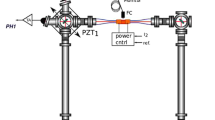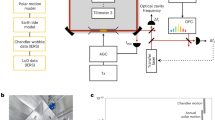Abstract
The precise measurement of Earth Rotation in Geodesy is not yet possible with inertial sensors since their resolution, and more importantly their stability, is still insufficient. Mechanical gyros and fibre optic gyros are widely used in aircraft navigation and robotic systems. However the requirements for stability and resolution are far below of those in the geosciences. The successful construction of the Canterbury Ring Laser (C-I) has demonstrated that it is possible to build and operate large ring laser gyroscopes. An instrument (G = Grossring) with an area of 16 m2 and with two counterrotating laser beams following its circumference has the potential to provide Earth rotation measurements with a stability of 10-9 or better [3,4] . Based on experience with a simple (C-I) ring laser a monolithic prototype (C-II) of such a large ring laser was designed and built in order to investigate the properties of a very large ring laser. The concept, and the results obtained so far, are discussed.
Access this chapter
Tax calculation will be finalised at checkout
Purchases are for personal use only
Preview
Unable to display preview. Download preview PDF.
Similar content being viewed by others
References
G E Stedman, Ring laser tests of fundamental physics and geophysics, Rep. Progr. Phys. 60 615–688 (1997).
F. Aronowitz; The Laser Gyro, Laser Applications, M. Ross(ed), Academic Press, New York (1971), 1, 133–200
H.R. Bilger, G.E. Stedman, Z. Li, U. Schreiber, M. Schneider; Ring Lasers for Geodesy; IEEE Transactions on Instrumentation and Measurement, Vol. 44, 468–470 (April 1995).
H.R Bilger, U. Schreiber, G.E. Stedman; Design andApplication of Large Perimeter Ring Lasers; Proceedings of the Symposium Gyro Technology, Stuttgart, Sept. 1996 8.0–8.24 (1996).
R. Rodloff; A Laser Gyro with Optimized Resonator Geometry, IEEE Journal of Quantum Electronics, QE-23, 438–445 (April 1987)
M. Schneider; Himmelsmechanik, Band III Gravitationstheorie, Spektrum Akademischer Verlag, Heidelberg, 1996
U. Schreiber; Ringlaser Technologie für geowissenschaftliche Anwendungen, Habilitationsschrift, Mitteilungen des Bundesamtes für Kartographie und Geodäsie (Band 8)
Editor information
Editors and Affiliations
Rights and permissions
Copyright information
© 2003 Springer-Verlag Berlin Heidelberg
About this chapter
Cite this chapter
Schreiber, U., Schneider, M., Stedman, G.E., Rowe, C.H., Schlüter, W. (2003). Characterisation of the C-II Ring Laser. In: Grafarend, E.W., Krumm, F.W., Schwarze, V.S. (eds) Geodesy-The Challenge of the 3rd Millennium. Springer, Berlin, Heidelberg. https://doi.org/10.1007/978-3-662-05296-9_13
Download citation
DOI: https://doi.org/10.1007/978-3-662-05296-9_13
Publisher Name: Springer, Berlin, Heidelberg
Print ISBN: 978-3-642-07733-3
Online ISBN: 978-3-662-05296-9
eBook Packages: Springer Book Archive




